Blocky bagato-surface booths. Frame-panel bagato-surface dwelling houses of the same design
panel booth
Houses of the mass series were built near the places of the SRSR and the former countries of the Warsaw Pact, and the basis of the architectural look of the rich sleeping areas of these places.
Through Pol_tichnі, Іdeologіchnі, Demographer's Cause, Perigod Khrushchovskoy "Vіdligi" Bouv Proshoniki in the Istorії Radyancy of the Planning Ekonіki, if order of the Justice of the Important Combines, widespread the zb_lishennye virob innovation of the goods and the і vs, so chi іnakshy industrial. a complex of resource-saving sirovinnyh galluses.
On the other hand, until the mid-1980s, less than 85% of families were small in the neighborhood of an apartment: in 1986, Mikhailo Gorbachev put the term on 15 years, hanging out the words “Leather radiansky sim'ї - I will decorate an apartment until the year 2000.”
The prototype for the first “Khrushchevs” was the Block Budіvl (Plattenbau), which was built in Berlin and Dresden from the 1920s. The life of the living quarters of the “Khrushchevs” thrived from 1959 to 1985. In 1956-1965, more than 13,000 living houses were built in the Soviet Socialist Republic, and maybe all - five overheads. Tse allowed to randomly introduce 110 million rubles. square meters life. A viable production base and infrastructure was created: house-building plants, backwater plants, etc. The first house-building plants were created in 1959 in the Golovleningradbudu system, in 1962 they were organized in Moscow in other places. Zokrema, for the period 1966-1970, near Leningrad, 942 thousand people occupied the living area, and 809 thousand moved into new houses and 133 thousand took away the area in old houses. Z 1960 the life of the living 9-surface is conducted. panel booths, since 1963 - 12-surface.
Technology
Components panel booth large concrete slabs, which represent themselves, are made in factories. For yak_styu be-yak_ vrobi, prepared in factory minds for іssuyuchimi GOSTs, and with proper technical control positive bik vіd vrobіv, vygotovlenyh directly on budmaydanchiku. The life of a panel booth is guessing the choice of a childish design set. Ready-made parts are delivered to the budmaydanchik, so the alarm clocks are left with less to install. After that, the productivity of work on such a dispute is even higher. The square of the budіvelny maidanchik is full of less for the need for the budіvnitstvі tseglyany budinka. Such trival and labor processes, like the installation of fittings or concrete, are typical for a monolithic residential life, completely switched off. І yakraz at tsmu fakhіvtsі y bachel the head of the war panel booth before other types of everyday life.
Typical series of booths
1940s
Since 1947, the Academy of Architecture of the SRSR has been carrying out the construction of an all-chosen large-panel dwelling. There will be frame-panel and frameless booths:
- 4-5-surface (Moscow, Leningrad, Magnitogorsk)
- 8-tops with panels for two tops (Moscow)
1950s
The height of 5 tops of the bula was taken to that, according to the current norms, the largest surface was, for which it was allowed to build booths without an elevator (at the same time, sometimes there were booths on 6 overs - with a store on the first version).
Beginning in the 1990s, they began to be called "Khrushchev" for a number of singing inconsistencies: little noise insulation and insufficient thermal insulation - cold weather and, on the contrary, unbearable heat. tops)
1960s
- 1-510 Block five-surface booths.
- 1-511 Tseglyany five-overhead booths.
- K-7 Panel five-surface booths. Moscow has been wreaking havoc since the beginning of the 1990s. Panels, from which there were huts, were lined with large square kahli with a side of about 5 cm. Boudinkas of similar and similar types were called among the people: "Khrushchobi". Another special feature is the elements of the frame that protrude along the corners of the room. Basically, the houses of this series were made up of 1, 2 and 3-room apartments, three apartments per version. Near the 1st microdistrict of Zelenograd there are also houses of a series of 4-room apartments (building 101-103). The height of the stele is 2.48 m (behind other vіdomosti 2.59 m). Vertical crest - approximately 2.85 m. Horizontal crest - 3.20 m. Internal concrete panels of the curtain 270 mm. Partitions - gypsum concrete panels with a thickness of 80 mm. Overlapping - reinforced concrete panels with a thickness of 220 mm.
- II-32- a series of panel five-overhead richly sectioned dwelling houses, one of the first series of an industrial house, the basis of one of the districts in the mass dwelling forgetfulness of the 60s. Moscow has been wreaking havoc since the beginning of the 1990s.
- II-29 Ceglyany 9-surface booths. In Moscow, one budinok of the series stands in the middle of the Boulevard Kilts (Kovpachny provulok, budinok 6 side 5)
- 1-335 Panel 5-surface living booth. Most often, it’s more common in every way huge SRSR a series of panel 5-surface hutches. Budinki of this series were produced from 1958 to 1966, after which they passed to the modernization of series 1-335a and 1-335d, and they were carried out through 1976 inclusive.
- 1-464 Panel 5-surface living house (Belarus).
- BM-4 A series of living quarters for regional centers and small towns (Belarus).
1970s
In 1970, the number of acceptances Single catalog of everyday parts, on the basis of what was given, typical projects were developed.
- series of booths (5-9 overhead booths)
- 1-515/9m
- 1-515/9sh
- 1605/9

budinok series II-18/12. Surface area: 12 Living space height: 2.64 m.
- II-18/9 - a series of block 9-(8-) top one-section (one-piece) living houses, one of the first series of houses in the raised surface of industrial house building.
- II-29
- II-49
- 1LG-600 (Avtivsky DSK) - this is the name of the "budinki-ships"
- 111-90 - a series of large-panel, richly sectioned living quarters of industrial households. The series was expanded by TsNDIEP Zhytla naprikintsi 1960s. Promislove Budіvnitstvo budіvel series 111-90 started on the cob of the 1970s. The back of the budinki was five-and nine-overhead, however, at the front of Veliky Novgorod, you can have three-overhead budinka budinki (for example, in Grigorovo).
- 111-108 A series of panel 9-surface booths (m. Vitebsk).
1980s
At the beginning of the 1980s, a series of COPE (composite volumetric and planning elements) was propagated near Moscow, recognized for forgetting “buffer zones” between Novobudov and zones of architectural monuments that are being protected, and zones of mass forgetfulness, as well as for “revitalizing » formed districts. The first houses of the series of buildings in 1982 were located near the Vorontsovsky park. The project has transferred the possibility of budding up to 22 surfaces. At one time, in the rich districts of Moscow and other places of the SRSR, faceless buildings continued to be built, allowing for some difference in the architecture of richly overlaid panel monsters.
1990s
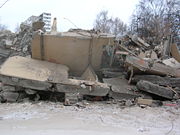
The ruins of the demolished Khrushchev near Moscow
Territories of 5-surface panel booths, which are carried, are forgotten by 17-25-surface ones. living booths, importantly with new series of panel booths.
2000s
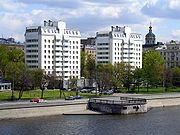
Typical nine rooftops of the 1960s along the Krasnokholmsky embankment, reconstructed on the cob of the 2000s
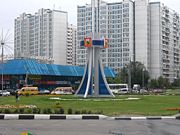
Center of the Novokosine district
- P-44T
- P-44TM
- P111M
- HMS-1
- I-155
- I-1723
The height of living quarters is 2.64 m. The successors of "KOPE" are approved by different people for the architecture of the residential boudinka-complexes.
- KOPE-M-SAIL
- Individual project monolith-cegla
- IP-46S
Types of apartments and their characteristics
Є kіlka kіlka klasifіkatsіy apartments. Extended abbreviations and decoding:
- xp(Khrushchovskaya planning, out of Khrushchevka) - steles 2.5 m, small kitchens - 6 sq.m.
- UP(shorter planning) - three times better for Khrushchev, kitchen 6-8 sq.m.
- PG(oversized)
- ate(elite)
- Pg- Fully sized apartments - tse budinki, zbudovani before Khrushchev's housing reform. Stinks can be high walls up to 3.5 m, large kitchens up to 15 sq.m., living area of apartments: 110 sq.m. triple rooms up to 40 sq. one-room. Rooms in these apartments are insulated, separate bathrooms, large skhodov maidanchiki. Budinki of 3, 5 on top, as a rule, are full.
- Xp- Khrushchovka - ce living 4, 5 overhead houses, zbudovani during the period of the Khrushchev housing program, if in war hour the country demanded massive and inexpensive life. That was why there were apartments of small area, compact, as a rule, summіzhnі kіmnati with low stelae, a total area of 60 sq.m. trikimnatni, 43 sq. double room and 30 sq.m. one-room apartments, with small kitchens (5-6 sq.m.), mixed bathrooms and balconies not in all apartments.
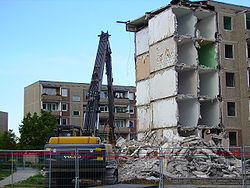
- Type. or Art.- Typical or Standard planning of apartments - for apartments of the next generation (after the Khrushchev hour) generation: the height of the stele is 2.6 m to 2.75 m, the total area of apartments is 63 sq.m. triple rooms up to 33 sq. single-room, kitchens 6-7 sq.m., bedrooms near two-rooms are insulated, in three-rooms - sumo-insulated, bathrooms, as a rule, insulated, balconies and loggias. Tse budinki 5, 9 overhead with a direct connection to the wire and elevators. The main mass of tsikh budinkіv was inspired from cast-in-place concrete panels.
- U/P- Flats of a painted plan with 9 panels on top of the house with a larger area of apartments: 69 sq.m. trikimnatni, 53 sq. double room and 39 sq.m. one-room apartments, as well as an enlarged kitchen area up to 9 sq.m., all rooms are insulated, bathrooms, balconies and loggias. The booths are equipped with elevators and smіttєprovodami.
- El.- Elite apartments, or apartments of a new generation, do not create a border for the area, they are different in their own planning. Most of the time, the future Vlasnik plans his life himself. Provision of a great number of services - underground garages, smіttєprovіd, elevators as a passenger, so vantage, komori and vegetables, large descents maidanchiki, sruchnі pіd'їznі kolії, mozhlivі gyms, saunas and other
Elements of panel budіvel
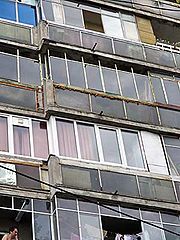
One type of painting on the eyes of old Radyansk budіvels - handicraft-glazed balconies
- Schabel;
- Engineering systems.
Other countries
For the exhibition "Autumn Salon" in 1922, Eduard Le Corbusier and P'er Jeanneret presented the project "Today's Place for 3 Million Residents", in which the new city of the city of the future was evoked. This year, the whole project of transformations on the "Plan Voisin" () - the proposition of a radical reconstruction of Paris was blamed. The plan of Voisin transferred the life of the new business center of Paris to a cleared territory. For whom it was necessary to bring down 240 hectares of old forgetfulness. Sixteen of the same hmarochosiv-offices for 50 surfaces according to the plan were spread out freely, sufficient to each other. The area, which is forgotten, became only 5%, and 95% of the territory was built under the highway, parks and pishohidnі zones. "Plan Voisin" was widely discussed in the French press and became a kind of sensation.
In 1924, a project of Corbusier town called "Suchasny Fryuzhet's houses" ( Quartiers Modernes Fruges). This place, which is made up of 50 two-three overhead living houses, was one of the first signs of the life of houses in series (in France). There are stashes of chotiri tipi budіvlі, raznі for configuration and planning - strіchkovі budinki, blocking and okremi. For this project, Corbusier tried to know the formula of a daily booth at affordable prices - simple forms, clumsy in everyday life and what can be done with it modern equal comfort.
At the International Exhibition of Contemporary Decorative and Industrial Arts in 1925 in Paris, the Esprit Nouveau pavilion was built for the Corbusier project ( L'Esprit Nouveau). Pavilion including living quarters bungalow life-size - an experimental apartment for two equals. A similar middle of the Corbusier victorious later, for example, the 40s, when Marseilles Zhytloy Odinitsa. Block of Marseilles (1947-1952) - a rich apartment house near Marseilles, planted apart in a spacious green space. Corbusier won against this project of a standardized “duplex” apartment (near two equals) with loggias, which overlook the front side of the booth. In the middle of the day - in the middle, beyond the height - there is a large complex of services: a cafeteria, a library, a post office, grocery stores and more. On the enclosing walls of the loggias, on such a scale, rose painting was painted in clear colors - polychromy. Similar Zhitlovsky Odinitsy (partially modified) were recreated in the towns of Nantes-Réze (1955), Meaux (1960), Brie-en-Foret (1961), Firmin (1968) (France), near Western Berlin (1957). These disputes inspired the idea of Corbusier's "Promeniste Place" - a place that is friendly to people. In 1950, on the request of the Indian government to the state of Punjab Corbusier, having embarked on the largest project of his life - the project new capital state, Chandigarh. Like in the Marseilles bloc, a special technology for processing the concrete surface, the so-called “béton brut” (French - unfinished concrete), was zastosovan for the perfect processing. This technique, which became a specialty of Le Corbusier's style, was later developed by the architects of Europe and other regions, which made it possible to speak about the new trend of "brutalism". Brutalism has the greatest breadth in Great Britain (especially in the 1960s) and in the SRSR (especially in the 1980s) on the cob of the 1980s. . Zahidnu Europe was flooded with a flurry of protests against this kind of forgetfulness. Since then, brutalism has become accepted as an incorporation of the greatest features of modern architecture (experience in the needs of people, soullessness, claustrophobia, etc.), that demand has begun to be born. Inspirations behind the plan are the place of Brasilia, the capital of Brazil, the creations of Le Corbusier’s house, and including famous people in the whole world, examples of typical living houses, developed by him in the 20-40s.
Terminology
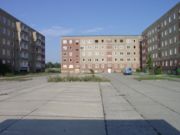
"plattenbau" ("panel wake")
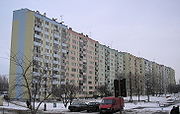
Poland
- Russia: "panel booth", "Block booth" or just "block"
- Czech Republic: Panelák
term panelak Vikoristovuєtsya specially according to the date to the block houses, which were in the Czechoslovak region. There were similar booths in others socialist countries, and navigate to Western Europe. Equivalence of panels (the Czech term "panelak" (panelák)) in other words:
- French: Maison a panneaux
- German: Plattenbau / "plattenbau" ("panel wake")]
- Austria: Gemeindebau / "gemeindebau" ("community life")
- Bulgarian: panel block, panel
- Croatian: stambeni blok("tiled block")
- Slovak: Panelovy dom("panel booth")
- Polish: Blok, Wielka plyta("Wielka (great/great) pvyta") (block houses in Poland on Wikimedia Commons)
- Romanian: block
- italian: Casa prefabricata
Panel living life- one of the ways of choosing life, foundations on the basis of victoria in front of the production of great concrete panels and slabs of factory production with the construction of great living, administrative and community life.
The main types of panel budіvel, which are built in the present hour, are framed and frameless. Before the first type, frame-panel ones are used, and before the other - large-panel ones. Installation of both types will be carried out from industrial selected cast-iron structures.
Frame bud_vl_
Frame-panel buildings are subdivided into two constructive schemes: with a top frame and with an internal frame.
Budіvlі, zvedenі behind the scheme "upper frame" constructively є spacious frame, which is set up for the help of zvnіshnіh supporting stіyok-columns and ribs of overlapping panels. Panels of walls and internal partitions are fastened to the st_yk of the frame, as if they were not load-bearing. In addition, before the scheme of the "lower frame" one can see the transverse and later frame.
In booths of the “internal frame” type, external supporting columns are daily, and the role of load-bearing ones is played by internal columns and panels of external walls, where overlapping slabs are spiraled.
The span of frame-panel buds should be 5.6 m or 6 m. Z'ednanny crossbars and columns are zvarne. Columns are made of consoles, as they pass through the cracks, and they are made of rolled double-tee steel. The crossbars spiral on the center of the console, with their lower part, the visor with the pins.
At the frame houses of the raised surface (curtains from 12 to 16 on the top and above), the croc between the transverse frames should be 6 m, which allows for more space planning.
The height of the surface of the raised surface, fallow in their recognition, can become:
- Administrative budіvlі, medichnі ta initial mortgage- 3.3 m;
- Zhytlov budinki and hotels - 2.8 m;
- Design bureaus, trade centers, laboratory buildings - 3.6 m or 4.2 m.
Bezkarkasnі budіvlі
Velikopanelnі budіvlі vіdnosyatsya to the type bezkarkasnyh. Fallow in the surface of the future and її prichennya, іsnuyet raznі constructive schemes.
Large-panel living buds and boudins of the gothic type of curtains up to five tops are divided into three main schemes:
- Budinki with non-supporting external and internal transverse and posterior partitions;
- Budinki with self-supporting oval walls and non-supporting transverse partitions;
- Budinki with outer and inner late walls.
At the booths with transverse partitions, internal transverse partitions protrude as load-bearing elements, where the overlapping plates spiral. Outdoor panels in such booths are marginally lighter and enlarged and protrude only like fencing elements, shards of vanity are not accepted by them.
Construction elements
Razrіznyayut panels for walls and inter-overhead panels of overlappings. For walls, internal and external panels are made. These expansions are laid down at the stage of the project and without intermediary lie down in the expansion of the site. Also, to the elements of a large-panel booth, you can see the descents of the maydanchiki and marches, sanitary and technical cabins, elevator shaft blocks, ventilation blocks, as well as fenced screens of balconies and loggias.
Exterior wall panels are produced in two main varieties:
- Made from lightweight cast concrete;
- Bagatosharovy sandwich panels.
Zovnіshnі stіnovі panelsі, scho vikoristovuyutsya in booths with a constructive scheme of the type "transverse partitions", vibrating from vikoristannyam light budіvelіnі materials: claydite-fiber-reinforced concrete, porous concrete.
Dovzhina panels for ovnishnіh walls, scho zastosovuyutsya in five-overhead booths, dorivnyuє kroku transverse panel walls-partitions. Fallow in recognition of the future façade panels are let out of the advancing expansions: 2.5 m; 2.8 m; 3.2 m; 3.6 m and 6 m.
Rich hollow-core slabs
They are prepared as single balls, and as materials, light or superb cast concrete is used. Fallow in their own comrades, internal panels can stand up like a load-bearing wall, and like a panel of diaphragms of hardness. Internal walls, which are not installed as load-bearing, mainly, like walls-partitions of light construction.
There are three main types of overlap plates:
- Refurbished cast-in-place concrete panels;
- Chastkovo selective-monolithic slab elements from a ball to concrete;
- Rich empty slabs - with round empty slabs.
For living houses with a height of 16-25, on top of the catalog of industrial buildings, a frame constructive scheme has been transferred. Frames of large-panel living budіvel with a height of 16-25 cm on top of the slabs are selected from factory-prepared cast-iron concrete elements.
Behind the nature of the static robot, three types of frames are distinguished: frame, viscous and frame-viscous. In frame frames, all vertical and horizontal tensions are taken up by frames with solid knots.
In ligature frames, the columns and girders of the frame are loosened with less vertical tension with hinged connections at the nodes, and wind and other horizontal tension through the crossbars are transmitted to the multiple transverse vertical tie (diaphragms of rigidity).
In some cases, the frame is designed for a combined frame-link scheme with the transfer of vertical links on the transverse frames with hard knots, and horizontal links - vertical links of the diaphragm and hardness (like in a link system).
In the modern framed large-paneled living boudinkas, the elevated surface is blocked by the head rank of the zv'yazkovu constructive scheme. With this scheme, it is equal to the frame, the steel wool is reduced by approximately 20%; In addition, the linking scheme for the security of the independence of the crossbars in their position near the plan is beyond the height of the life, which makes it possible to completely unify the crossbars and their supporting nodes.
Unification frame, adopted by the catalog of unification experiments for the system of linking, buv look (). This frame is made up of two-top columns with 400x400 mm perforation, 150 mm villot consoles, 400x450 mm row crossbars and 220 mm hollow decking, internal width (nominal) 1200, 1800 and 0 04.
The openness of the hardness of the frame is provided with hardness diaphragms, as it is recommended to design at the sight of spacious walls for the entire width of the building from the cast-in-place concrete panels with a thickness of 180 mm, behind the columns, to the openings of the fittings or to the embedded parts and the monolithic ones.
On fig. 253 showing elements of a unified prefabricated prefabricated concrete frame; double-topped columns, row crossbar, outer crossbar, hardness diaphragm and її z'ednannya with the column, as well as expansion of the hardness diaphragm at the plan.
The most important in the choice of cast-iron concrete frame is the construction of column sticks. There are two main types of sticks, which are transmitted through steel heads and from concrete to concrete.
For the power of sticks of the first type, it is necessary to use a lot of metal and the stink of labor in preparing. Larger rationals of another type, in some cases from concrete to concrete, are transmitted through the end faces of the spherical surfaces of the columns (Fig. 254, c). Reinforcement sticks are used for auxiliary baths.
Such a construction of the stick was adopted for a unified frame. However, later it was installed that simple sticks with flat ends of columns, mesh reinforcement, With a central pressure, they can change the magnitude of the stress, which outweigh the prismatic strength of concrete by 5-10 times. The preparation of the sticks is richly simpler, lower spherical. Also, flats were accepted for the catalog of industrial products. At the end of the column, the reinforcement is reinforced with transverse studded meshes, flat ends may be centered concrete maidan, which protrudes by 20-25 mm and may mesh (Fig. 254, b). Reinforcement outlets are fixed to the baths and the stick is monolithic.
For re-creating frame buds, the catalog transfers round-hollow panels with a thickness of 220 mm and a width of 800, 1200, 1800, 2400 and 3000 mm.
The design of the crossbar support unit on the column and the parigel flooring is shown in fig. 255. Lifting the crossbar with the column, vikonano with the “attached console”. The hanging panels of the outer walls at the frame booths are preceded by a catalog of the same as those of the panel ones, behind the vignette of the panels of the outer walls and the inner edgings of the buds, the pilaster and the edging panels of the ledges of the outer walls (Fig. 256). Cі panels are made from expanded clay concrete: their thickness is taken 340 and 300 mm.
The panels of the outer walls are installed with modular splitting axles with advancing bindings (small 257): the inner edge of the wall is named for the modular height by 400 mm, or the inner edge of the wall goes into the middle of the wall by 200 mm for the modular weight. The inner plane of the apex panels of the ledges of the outer walls of 1200 and 1800 mm is to be blamed for the name of 220 mm for the modular height.
A system of attachments has been adopted that allows passing risers of scorching between the wall and the column, installing in the necessary recesses of the panel of the outer walls so that the inner surface of the wall sags from the inner edge of the column, for which the columns are not attacked. In addition, the binding of the apex panels of the ledges of the outer walls ensures maximum proximity to the column and the crossbar, which makes it easier to hang them on the frame.
The outer walls of the panels at the frame booths are spiraled either on the edge element of the overlapping of the flooring-roofing, or on the outer later crossbar. Fasten wall panels to the column for additional steel plates welded to embedded parts.
On fig. 258 displays wall panels on the element of the unified frame and the structure is fastened. On fig. 259 shows another version of the spiral wall panels of the outer walls on the outer crossbar of the frame, which corresponds to the type of crossbar and attachments, presented by the catalog of unified profiles for Moscow.
For vashtuvannya loggias near the frame booths, the overhead walls of 1 loggias, which are inserted at the vertical seam between the panels of the outer walls, are spiraled on the console of the wall columns (Fig. 260).
The slabs of the loggia are laid on top of the upper hanging walls, and the lower slab is lifted up to the lower wall of the loggia on the wall, so that the wall carries, in such a rank, two slabs.
The thickness of the middle walls of the loggias is taken equal to 200 mm, the outer ones - 100 mm. The slabs of the loggia spiral onto the walls of the loggia by 90 mm.
All slabs, behind the veneer of slabs for sinking loggias and slabs, which are installed in the places of the ledges of the outer walls, stop at once in the frame panel booths. Loggia slabs with a width of 1200 mm - at the same time with slabs of balconies in frame houses, they spiral not on the walls of the loggias, but on the console, which are welded in the same places to the columns (small 261).
Cream of reinforced concrete slabs of balconies, which are laid on the console, in the nomenclature of the transfer of expanded clay concrete slabs of balconies, which is the continuation of the overlap, which is released through the horizontal seams between the panels.
Like the butt of a frame-panel booth on the surface of a 20-surface five-section frame living booth for 807 apartments, a project of such a design based on the catalog of industrial plants for Moscow. At the booth there are apartments in 1, 2, 3, 4 and 5 rooms.
The apartments are designed according to the principle of zoning. Group of applications, open for all families Zagalna kіmnata that first front, seen in the first zone, stashed closer to the entrance. Bedrooms, rooms, a sanitary vuzol from a bathroom and another corridor form another area.
The kitchen is located between the zones, the entrance to the yak is located near the main entrance and at the same time it is not remembered for the entrances (small 262, a). In 4-5-room apartments, two sanitary facilities have been designed: confusion - near the bedroom area and a small bathroom (toilet and washbasin) - near the kitchen area and the first front.
During the development of the project, the booth was tested, according to the possibility of using it, typical for the frame work, the ledges of the columns at the corners of the rooms (div. Fig. 262, a).
The skin section of the booth has three lifts: one passenger and two passenger-vanage. With the best method anti-burn care evacuation descends of guilt for the inter-commitment to the future with the authorities in the transition to it. With such a solution, the possibility of smoke-filled exits during fire is turned off, even as the most significant exits (with the passage through the loggias) still do not turn off the smoke through the elevator shafts, ventilation systems and other communication shafts.
On fig. 262 b showing the plan of an ordinary section of a framed 20-surface booth with a vineyard walkway.
When designing frame-panel booths with a height of 25 m and more vicorous, constructive scheme monolithic hardness core, like taking all the horizontal pressure and ensuring the open space of everyday life. The core of the zhorstkost roztashovuyut at the middle part (in the basht-type booths) or symmetrically to the central axes (at the booths of great length, small 263), in the new one, all vertical communications (lift shafts, get off) should sound.
The core of the hardness is built up in a rough formwork for the help of a special unit, which has a forged formwork and a jack stand.
The constructive scheme will be built with a monolithic core of hardness compared with schemes about flat walls of hardness, the cost of labor is increased by 6%, for the cooperation in the preparation and installation of the structure - by 14%, for capital investments in the building of the structure - by 10%, for - 15% .
At the booths, there are 16 tops in height, in which 800 T can reach one support, and more, it is possible to build strong solid cast-concrete monolithic foundation ribbed slabs, which spread the pressure over the entire area of the booth base. So, under 25-storey booths on Kalinina Avenue in Moscow, monolithic ribbed foundation slabs 600 mm with ribs were laid with a splendid height 2000mm.
In case of great developments and development of rocky continental soils at a depth of over 10-12 m, promising types of foundations and bored pits of the "Benotot" system are to be built in such a way. For the help of two vertical hydraulic jacks, fixed on the drilling rig EDF-55 (French company "Benoto"), they bury metal casing pipes at the ground, which are to be hung on the lower ends of the cutting attachments. To ease the drilling of the casing pipe, alternate the wrapping ruh behind the help of two other hydraulic horizontal jacks. The soil from the pipe is removed with an impact grapple. After lowering the pipes to the required depth, they install reinforcement in it and lay the concrete bag.
Under the hour of concreting, the casing pipe for the help of vertical jacks is lifted, then lowered, as a result of which the concrete is strengthened. Then the casing pipe is taken out of the Sverdloviny and on the її mіstsі the concrete scorch is laid.
Drilling rig "Benoto" gives the possibility of drilling and concreting supports with a diameter of 88, 108 and 120 cm at a depth of up to 70 m. Under 32 columns, the frame was sporuded with stuffing of the fire with a depth of up to 20 m from the depth of the fire to the skin up to 600 tons.


